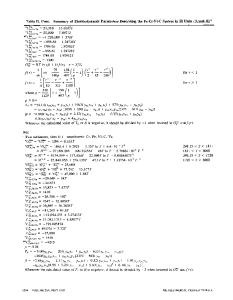Thermodynamic assessment of the Ni-Ru system
- PDF / 83,729 Bytes
- 3 Pages / 612 x 792 pts (letter) Page_size
- 24 Downloads / 574 Views
Section I: Basic and Applied Research
Thermodynamic Assessment of the Ni-Ru System Samuel Hallstro¨m
(Submitted 2 June 2003; in revised form 21 February 2004) The Ni-Ru system is assessed using the CALPHAD technique. The only available experimental information for this system concerns phase equilibria, whereas no thermochemical information has been found. The THERMO-CALC software is applied to obtain Gibbs energy (G) functions for the individual phases. The phase diagram calculated from the new G functions is in excellent agreement with the experimental diagram, and all the thermodynamic parameters are given in the Appendix. In addition, tentative activity diagrams and the metastable miscibility gaps in fcc and hcp phases are calculated from the new thermodynamic description.
1. Introduction Ruthenium (Ru) is considered to be a potential substitute for platinum (Pt) in the bond coat in gas turbine engines.[1] Thus, there is a need to compare the thermodynamics and kinetics of the two elements in various alloys. As a first step, it should be interesting to compare the thermodynamic properties and the ternary phase diagrams of the Ni-Al-Ru and Ni-Al-Pt systems. The Ni-Al system has already been assessed by Ansara et al.[2], Dupin and Ansara,[3] and Sundman,[4] and the Al-Ru system has been assessed by Prins et al.[5] The purpose of the present report is to assess the Ni-Ru system. The ternary system Ni-Al-Ru will be assessed in a coming report.
2. Experimental Data Pure nickel (Ni) is face-centered-cubic (fcc), whereas Ru is hexagonal-close-packed (hcp). The form of the Ni-Ru phase diagram is well known.[6] It is a simple peritectic with high mutual solubilities in the two solid phases. To the knowledge of the present author, no thermochemical data are available in the literature. Thus, the assessment must be based on phase diagram data only. Raub and Menzel[7] and Kornilov and Myasnikova[8] used thermal analysis to measure the liquidus and solidus temperatures for a series of alloys. In both cases, the composition was evaluated from the x-ray lattice parameter data. No measurements have been made on the hcp liquidus with Ru content higher than 50 atomic percent (at.%), but Kornilov and Myasnikova[8] determined the hcp solidus up to 62 at.%. The experimental uncertainties could not be found in the articles. However, the data of Raub and Menzel[7] and Kornilov and Myasnikova[8] are in good agreement for the hcp liquidus and solidus, but are not in equally good agreement for the fcc liquidus and solidus. Tryon and Pollock[9] investigated three diffusion couples of nominally pure Ni and Ru at temperatures of 1000 °C, 1100 °C, and 1250 °C, and used EPMA to obtain concenSamuel Hallström, Department of Materials Science and Engineering, Royal Institute of Technology, KTH 100 44 Stockholm, Sweden. Contact e-mail: [email protected].
252
tration profiles from which phase diagram data were obtained. Their error estimate for their solvus values is on the order of 1 at.%, and their determinations are in close accord with th
Data Loading...











